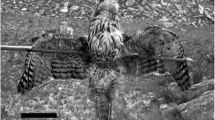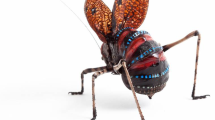Abstract
The frequency of pursuit-deterrent signaling should vary with predation risk for factors affecting decisions to flee and hide. Distance to refuge, temperature, and microhabitat types affect risk, and their effects may differ among defenses. Because risk is greater farther from refuge and at lower temperatures that impair escape ability in ectotherms, I predicted that when farther from refuge ectothermic prey flee sooner, enter refuge more frequently, and signal more frequently. At low temperatures, prey should flee sooner, enter refuge, and signal less frequently. Because signaling sometimes deters attack, lowered risk might allow prey to permit closer approach when signaling. In the zebra-tailed lizard Callisaurus draconoides, which signals by waving its tail, signaling and the other behaviors were affected by the same risk factors. Probability of signaling before fleeing increased with distance to refuge and temperature, but variation in temperature accounted for the effect of distance to refuge. Lizards signaled not at all at low temperatures, after starting to flee at intermediate temperatures, and before, during, and after fleeing at higher temperatures. This pattern is consistent with honest signaling of escape ability. Refuge entry was more frequent nearer refuge (lower risk) and at lower temperature (higher risk). Display was less frequent on rock than ground, possibly due to conspicuousness or delay in attaining high speed. Flight initiation distance was shorter after signaling. This novel finding suggests that signaling reduces risk and prey alter escape decisions based on lower risk as a consequence of their own signaling behavior.


Similar content being viewed by others
References
Bender H (2006) Structure and function of the eastern grey kangaroo (Macropus giganteus) foot thump. J Zool 268:415–422
Bergstrom CT, Lachmann M (2001) Alarm calls as costly signals of antipredator vigilance: the watchful babbler game. Anim Behav 61:535–543
Blamires SJ (1999) Factors influencing the escape response of an arboreal agamid lizard of tropical Australia (Lophognathus temporalis) in an urban environment. Can J Zool 77:1998–2003
Bulova SJ (1994) Ecological correlates of population and individual variation in antipredator behavior of two species of desert lizards. Copeia 1994:980–992
Caro TM (1986) The functions of stotting in Thomson's gazelles: some tests of the predictions. Anim Behav 34:663–684
Caro TM (2005) Antipredator defenses in birds and mammals. University of Chicago Press, Chicago
Cohen J (1992) A power primer. Psychol Bull 112:155–159
Cooper WE Jr (1997a) Escape by a refuging prey, the broad-headed skink (Eumeces laticeps). Can J Zool 75:943–947
Cooper WE Jr (1997b) Threat factors affecting antipredatory behavior in the broad-headed skink (Eumeces laticeps): repeated approach, change in predator path, and predator's field of view. Copeia 1997:613–619
Cooper WE Jr (1998) Effects of refuge and conspicuousness on escape behavior by the broad-headed skink (Eumeces laticeps). Amphib Reptil 19:103–108
Cooper WE Jr (2000) Effect of temperature on escape behaviour by an ectothermic vertebrate, the keeled earless lizard (Holbrookia propinqua). Behaviour 137:1299–1315
Cooper WE Jr (2001) Multiple roles of tail display by the curly tailed lizard Leiocephalus carinatus: pursuit deterrent and deflective roles of a social signal. Ethology 107:1137–1149
Cooper WE Jr (2003) Effect of risk on aspects of escape behavior by a lizard, Holbrookia propinqua, in relation to optimal escape theory. Ethology 109:617–626
Cooper WE Jr (2006) Risk factors affecting escape behaviour by Puerto Rican Anolis lizards. Can J Zool 84:495–504
Cooper WE Jr (2007a) Escape and its relationship to pursuit-deterrent signalling in the Cuban curly-tailed lizard Leiocephalus carinatus. Herpetologica 63:144–150
Cooper WE Jr (2007b) Compensatory changes in escape and refuge use following autotomy in the lizard Sceloporus virgatus. Can J Zool 85:99–107
Cooper WE Jr (2008) Visual monitoring of predators: occurrence, cost and benefit for escape. Anim Behav 76:1365–1372
Cooper WE Jr (2009a) Theory successfully predicts hiding time: new data for the lizard Sceloporus virgatus and a review. Behav Ecol 20:585–592
Cooper WE Jr (2009b) Optimal escape theory predicts escape behaviors beyond flight initiation distance: risk assessment and escape by striped plateau lizards Sceloporus virgatus. Curr Zool 55:123–131
Cooper WE Jr (2009c) Variation in escape behavior among individuals of the striped plateau lizard Sceloporus virgatus may reflect differences in boldness. J Herpetol 43:495–502
Cooper WE Jr (2010a) Economic escape. In: Breed MD, Moore J (eds) Encyclopedia of animal behavior, vol 1. Academic, London, pp 588–595
Cooper WE Jr (2010b) Pursuit deterrence varies with predation risks affecting escape behaviour in the lizard Callisaurus draconoides. Anim Behav 80:249–256. doi:10.1016/j.anbehav.2010.04.025
Cooper WE Jr (2010c) Risks associated with predator immobility, movement direction, and turn direction similarly affect pursuit-deterrent signaling and escape by zebra-tailed lizards (Callisaurus draconoides). Ethology 116:866–875
Cooper WE Jr (2011) Timing during predator–prey encounters, duration and directedness of a putative pursuit-deterrent signal by the zebra-tailed lizard, Callisaurus draconoides. Behaviour 147:1675–1691
Cooper WE Jr, Frederick WG (2007a) Optimal flight initiation distance. J Theor Biol 244:59–67
Cooper WE Jr, Frederick WG (2007b) Optimal time to emerge from refuge. Biol J Linn Soc 91:375–382
Cooper WE Jr, Frederick WG (2010) Predator lethality, optimal escape behavior, and autotomy. Behav Ecol 21:91–96
Cooper WE Jr, Perez-Mellado V, Baird TA, Caldwell JP, Vitt LJ (2004) Pursuit deterrent signalling by the Bonaire whiptail lizard Cnemidophorus murinus. Behaviour 141:297–311
FitzGibbon CD (1994) The costs and benefits of predator inspection behaviour in Thomson's gazelles. Behav Ecol Sociobiol 34:139–148
Hasson O, Hibbard R, Ceballos G (1989) The pursuit deterrent function of tail-wagging in the zebra-tailed lizard (Callisaurus draconoides). Can J Zool 67:1203–1209
Hemmi JM, Merkel T (2009) High stimulus specificity characterizes anti-predator habituation under natural conditions. Proc Biol Sci 276:4381–4388
Hertz PE, Huey RE, Nevo E (1982) Fight versus flight: body temperature influences defensive responses of lizards. Anim Behav 30:676–679
Holley AJF (1993) Do brown hares signal foxes? Ethology 94:21–30
Huey RB (1982) Temperature, physiology, and the ecology of reptiles. In: Gans C, Pough FH (eds) Biology of the Reptilia, vol 12, Physiology C: physiological ecology. Academic, London, pp 25–91
Lima SL, Dill LM (1990) Behavioral decisions made under the risk of predation: a review and prospectus. Can J Zool 68:619–640
López P, Civantos E, Martín J (2002) Body temperature regulation in the amphisbaeniana Trogonophis wiemanni. Can J Zool 80:42–47
López P, Hawlena D, Polo V, Amo L, Martín J (2005) Sources of shy-bold variations in antipredator behaviour of male Iberian rock lizards. Anim Behav 69:1–9
Marcellini D, Jenssen TA (1991) Avoidance learning by the curly-tailed lizard, Leiocephalus schreibersi: implications for antipredator behavior. J Herpetol 25:238–241
Martin J, Lopez P (2000) Costs of refuge use affect escape decisions by Iberian rock lizards Lacerta monticola. Ethology 106:483–492
Martin J, Lopez P (2003) Ontogenetic variation in antipredator behavior of Iberian rock lizards (Lacerta monticola): effects of body-size-dependent thermal-exchange rates and costs of refuge use. Can J Zool 81:1131–1137
Martín J, López P (1999) When to come out from a refuge: risk-sensitive and state-dependent decisions in an alpine lizard. Behav Ecol 10:487–492
Murphy TG (2006) Predator-elicited visual signal: why the turquoise-browed motmot wag-displays its racketed tail. Behav Ecol 17:547–553
Rand AS (1964) Inverse relationship between temperature and shyness in the lizard Anolis lineatopus. Ecology 45:863–864
Rocha CFD, Bergallo HG (1990) Thermal biology and flight distance of Tropidurus oreadicus (Sauria Iguanidae) in an area of Amazonian Brazil. Ethol Ecol Evol 2:263–268
Rosenthal R, Rubin DB (2003) r equivalent: a simple effect size indicator. Psychol Methods 8:492–496
Ruxton GD, Speed M, Sherratt TN (2004) Avoiding attack: the evolutionary ecology of crypsis, warning signals and mimicry. Oxford University Press, Oxford
Shine R, Kearney M (2001) Field studies of reptile thermoregulation: how well do physical models predict operative temperatures. Funct Ecol 15:282–288
Smith DG (1997) Ecological factors influencing the antipredator behaviors of the ground skink, Scincella lateralis. Behav Ecol 8:622–629
Stankowich T, Blumstein DT (2005) Fear in animals: a meta-analysis and review of risk assessment. Proc Biol Sci 272:2627–2634
Stevenson RD (1985) The relative importance of behavioral and physiological adjustments controlling body temperature in terrestrial ectotherms. Am Nat 126:362–386
Tanner WW, Krogh JE (1975) Ecology of the zebra-tailed lizards Callisaurus draconoides at the Nevada test site. Herpetologica 31:302–316
Vega-Redondo F, Hasson O (1993) A game-theoretic model of predator–prey signaling. J Theor Biol 162:309–319
Vitt LJ, Ohmart RD (1977) Ecology and reproduction of lower Colorado River lizards: I. Callisaurus draconoides (Iguanidae). Herpetologica 33:214–222
Vitt LJ, Zani PA, Caldwell JP, Carrillo EO (1995) Ecology of the lizard Kentropyx pelviceps (Sauria: Teiidae) in lowland rain forest of Ecuador. Can J Zool 73:691–703
Woodland DJ, Jafaar Z, Knight M-L (1980) The “pursuit deterrent” function of alarm signals. Am Nat 115:748–751
Ydenberg RC, Dill LM (1986) The economics of fleeing from predators. Adv Study Behav 16:229–249
Acknowledgments
I thank W. C. Sherbrooke for suggesting the study site and the arrangement of inexpensive housing.
Author information
Authors and Affiliations
Corresponding author
Additional information
Communicated by E. Fernandez-Juricic
Rights and permissions
About this article
Cite this article
Cooper, W.E. Pursuit deterrence, predation risk, and escape in the lizard Callisaurus draconoides . Behav Ecol Sociobiol 65, 1833–1841 (2011). https://doi.org/10.1007/s00265-011-1191-5
Received:
Revised:
Accepted:
Published:
Issue Date:
DOI: https://doi.org/10.1007/s00265-011-1191-5




